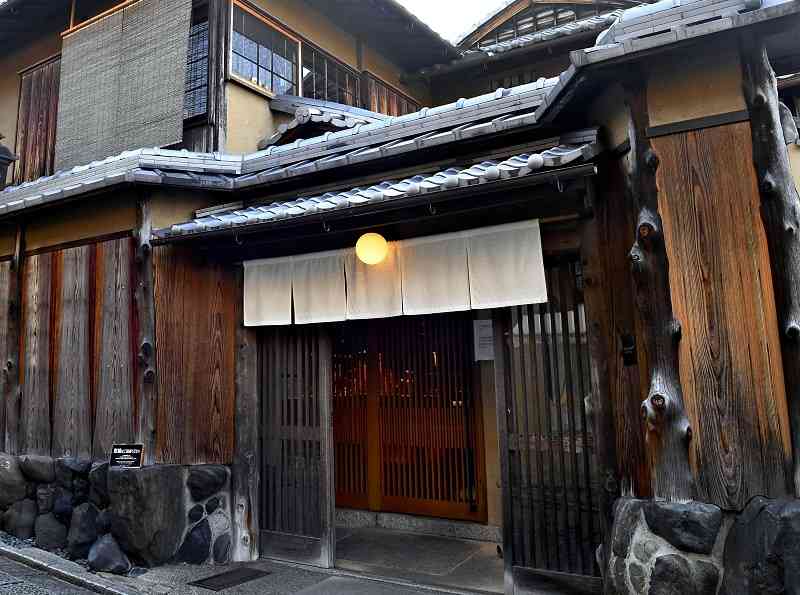
Customers stand near the Starbucks store in Ninenzaka, which is designed to blend into the old townscape, in Higashiyama Ward, Kyoto.
11:04 JST, January 14, 2023
KYOTO — On the Ninenzaka slope leading to Kiyomizu Temple, a World Heritage site in Kyoto, a 100-year-old machiya townhouse has been renovated into a Starbucks store.

A wooden Starbucks sign

A traditional Japanese curtain
The signboard depicting a siren from Greek mythology, the U.S. coffeehouse chain’s symbol, is made of wood, and a traditional Japanese curtain hangs from the eaves.
Such designs are intended to make the store blend into the local landscape, which has about 60 traditional buildings — many of them souvenir stores — lining the slope.
The unique shop reflects local residents’ dedication to the protection of the traditional town in Kyoto, one of the world’s most famous tourist destinations.
The coffee shop is a two-story building with a seating capacity of about 50. It features three gardens on the first floor and tatami rooms on the second. It is said to be the only Starbucks store among more than 30,000 worldwide where customers can take off their shoes to enjoy coffee.
As a queue outside the store might spoil the scenery, a waiting area accommodating about 10 people has been created inside the store. If people still try to wait outside, the staff will ask them to come back at another time.
Five years have passed since the store opened. Store manager Yoko Kikumoto said: “We’re part of the community. Together with the local people, we want to preserve Kyoto’s distinctive atmosphere.”
The store’s exterior and interior are not that of a typical Starbucks, but are the result of efforts by the community.

Customers drink their beverages in a tatami room at the Starbucks store.
In the area around Ninenzaka, there are still many townhouses built in the early 20th century or earlier. Local residents who run businesses in the houses have been trying to safeguard the area’s landscape since 1986.
A local council was established to set its own rules for the size and color of outdoor advertisements and to impose a ban on calling out to potential customers and distributing flyers on streets. These rules were clearly stated in a declaration made in 2009.

When residents learned that Starbucks was planning to open a store in the area, the council requested that the store be built in line with the declaration. It also sought to change Starbucks’ distinctive signage to one that would be in harmony with the surroundings, while also asking that lines not be formed outside the store.
“We’re responsible for protecting the wonderful townscape and preserving it for our grandchildren as our ancestors did for us,” 64-year-old resident Koen Shimada said. Shimada runs a doll workshop in the neighborhood and held discussions with the coffee chain as council chairman.
Starbucks responded to the council’s requests. Its signboards are usually plastic, but the company made a wooden one and set up the waiting area inside the store. It also restored the Japanese-style gardens that had been removed in the past.
“It’s become an architectural structure that will remain for the next 100 years,” said Kazuhiro Yanagi, who was in charge of designing the store.
Such a keen sense of autonomy appears to be a long-rooted tradition in Kyoto. In the 16th century, merchants formed self-governing bodies called chogumi, and from the 19th century onward, these bodies were reorganized into about 60 smaller organizations, which contributed financially to building 64 elementary schools in Kyoto. These organizations formed the foundation for current activities of the resident associations.
Like in Ninenzaka, more and more local councils have held preliminary discussions with businesses that plan to operate in their area. Kyoto has seen such action taken in 14 districts.
“There is no other big city where activities led by residents have taken root to this extent,” said Tohoku University Prof. Jun Mitarai.
Striking a Balance

The Kyoto city government has long placed focus on preserving the landscape. In 2007, it established regulations to restrict the height and design of buildings in the city center as well as banning rooftop signboards.
“Kyoto’s traditional townscape is what makes it Kyoto. It is a treasure not only of Kyoto but also of Japan,” said a city official.
However, the city also faces challenges. Its population is on the decline — as of Jan. 1, 2022, it stood at about 1.388 million, down 12,000 from the previous year. This marked the largest drop among the nation’s 1,741 municipalities.
Building height restrictions may preserve the landscape, but on the other hand, they reduce the supply of condominium units, which could force younger generations to leave the city and lead to stagnation of the regional economy.
A 40-year-old public servant working in Kyoto had to give up living in the city. Five years ago, when his first son was born, he bought an established house in Otsu in neighboring Shiga Prefecture.
“It takes about an hour to get to work, but a house in Kyoto was too expensive. Considering the cost of childcare, it was difficult to live in Kyoto.”
To address the problems, the municipal government revised its basic development plan to set a goal of attracting condominiums and commercial buildings in the southern part of the city, while continuing to preserve the landscape of the city center where temples, shrines and retro houses are concentrated. The maximum height restrictions will be eased or eliminated in the southern area. In areas south of JR Kyoto Station and around Umekoji Kyotonishi Station, the limit will be raised from 20 meters to 31 meters.
“In Kyoto’s urban areas, workplaces and residences were traditionally close together, but they have become places where only wealthy people can live,” said Tetsuharu Oba, an associate professor at Kyoto University. “It’s necessary to change the city in line with the times.”
However, some residents have opposed such development. One said: “Let Tokyo and Osaka do their urban development. Kyoto should remain cozy and compact.”
The ancient capital faces a difficult challenge of how to strike a balance between preserving its traditional townscape and creating an environment that is easy to live in.
Related Tags
"Features" POPULAR ARTICLE
-

Sanrio to Open Museum in Yamanashi Pref. Dedicated to Founder, Exhibits Include Hello Kitty, Other Characters
-

Autumn Foliage Surrounds Visitors to Tokyo’s Showa Kinen Park
-

My Daughter No Longer Speaks to Me, But I Want to See Her and My Grandchild
-

Kumamoto: Public Bath Refurbished as Library Where You Can Chat, Take Photos
-

Frozen Vegetables: Demand Rises for Convenient, Tasty Domestic Produce
JN ACCESS RANKING
-

Tokyo Economic Security Forum to Hold Inaugural Meeting Amid Tense Global Environment
-

Keidanren Chairman Yoshinobu Tsutsui Visits Kashiwazaki-Kariwa Nuclear Power Plant; Inspects New Emergency Safety System
-

Imports of Rare Earths from China Facing Delays, May Be Caused by Deterioration of Japan-China Relations
-

University of Tokyo Professor Discusses Japanese Economic Security in Interview Ahead of Forum
-

Japan Pulls out of Vietnam Nuclear Project, Complicating Hanoi’s Power Plans

























